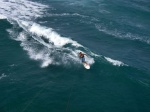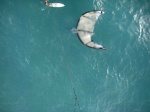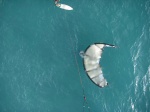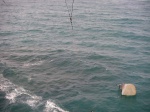
Here's an overview of Cabarete Bay with Bozo Beach to the west followed by Kite Beach. The wind is usually out of the east with thermal augmented trades in late morning on. You can see the reef and the swell zones it sets up. No wonder Bozo and Kite Beach go off in strong winds with nice swells. What's up with "X Kiter?" Is that the name of a Marvel comic, could make a great movie.

Paul is out playing in the waves with a camera up on an 8 m kite and a surfboard lower down. Mighty nice waves off Cabarete over the reef. On this day winds were east around 20 kts. with solid head high surf and what Paul calls "surprise waves" on tidal changes. Hey Paul, what's a surprise wave, something like a rogue wave only unannounced and smaller?

Paul was sliding along when he saw this guy kite down and drifting north offshore and towards the wave breaks. They were about a 1/2 mile out inside or south of the "X marks the spot" area. The guy got caught and gobbled by a breaking wave. His fifth line rig got all twisted up after to where relaunching wasn't feasible. This can happen fairly easily too so it is good to have a good way to deal with things.

Paul went out recovered the guy's board and brought it back to him. He figured the guy had two options. Including; 1. Paul could ride his board and drag his kite in while the kiter could paddle Paul's surfboard in, or; 2. He could self-rescue and sail in.
The kiter setup for Self Rescue by sailing in using the kite. Paul mentioned he often sees people simply turn the kite upside down and use it as a raft ignoring the substantial advantages of being able to sail in using the kite.

Once the kite was in position the kiter made shore in no time about 20 to 25 minutes and from a 1/2 mile out. You can see the rider with kite bent perpendicular to the wind from the east and tooling nicely shoreward to the south. Paul kept orbiting by to make sure he was doing ok throughout which is always a good policy when someone is making for shore in this way.
It can't be emphasized enough how vital it is for all kiters to know and have practiced bailing out using the kite to sail in on the water. A new kiter was found on their kite raft hours after dark, expired from hypothermia this year. Not sure if they could have sailed into shore or not without the effects of hypothermia stealing their options away. When severe cold effects are creeping in you need to move early otherwise options fall away. Then again in strong wind you can make up to a few knots and short distances can be covered fairly quickly. We'll never know. There have been still other serious cases out there.
I once used this to sail in from over a mile off the north shore of Antigua. Did the trip fast and easy and considering there was no way my kite was going to launch again before hitting shore, it was a good thing.
How do you do it? There is a video of one approach at: http://kitefilm.com/video/rescue_techniques_part1.wmv
The above example is with a small C kite in good wind, one of the easier scenarios to do this in. When they say watch out for (and EXPECT) lines to catch and tangle on you underwater believe it and be careful. Some advise winding at least one kite wing span of a single line (your kite leash line) on your bar first before winding all the lines up as you work towards the kite. In either case be very careful of breaking waves catching your kite and perhaps you as well with a stray line. More often than not you may have a flat kite and a larger one at that. The trick is to get enough of the kite canopy folded over perpendicular to the wind and making for the shore. You may need to let a little air pressure out of some leading edges to be able to fold them over. Just don't let too much out. Practice this before you need it for real to be able to better judge what you need to do and how it all comes together. With flat kites I've had some success working from the center of the kite wing tips up as shown in the second photo above. I will then pull in on one of the bridles from the shoreward facing wing tip, arching the kite over me. There is no need to hold both wing tips together with a larger kite as long as the wind sees enough of the kite canopy. You can control power or bleed it off if excessive by how far back you work along the leading edge towards the wing tip that is in the water. You can even steer very slightly closer to the wind by pulling the wing tip above the water across the line of the leading edge in the downwind direction. You can even lie on your back on the leading edge with one leg on top of your kite and sail in partially out of the water. I've even been able to mouth inflate the leading edge to be able to do this years in the past when the leading edge valve plug blew out on impact with water. Lots of ways of doing this, you just need to be practiced with a few. So, no excuses know how to do this. btw, wearing appropriate flotation/impact vest and carrying a knife may come in handy. If you are taking Pro Lessons make sure your instructor will teach you how to do this, don't take no for an answer.
Photos by Paul Menta's kite, what's it called, Wilbur?
*
